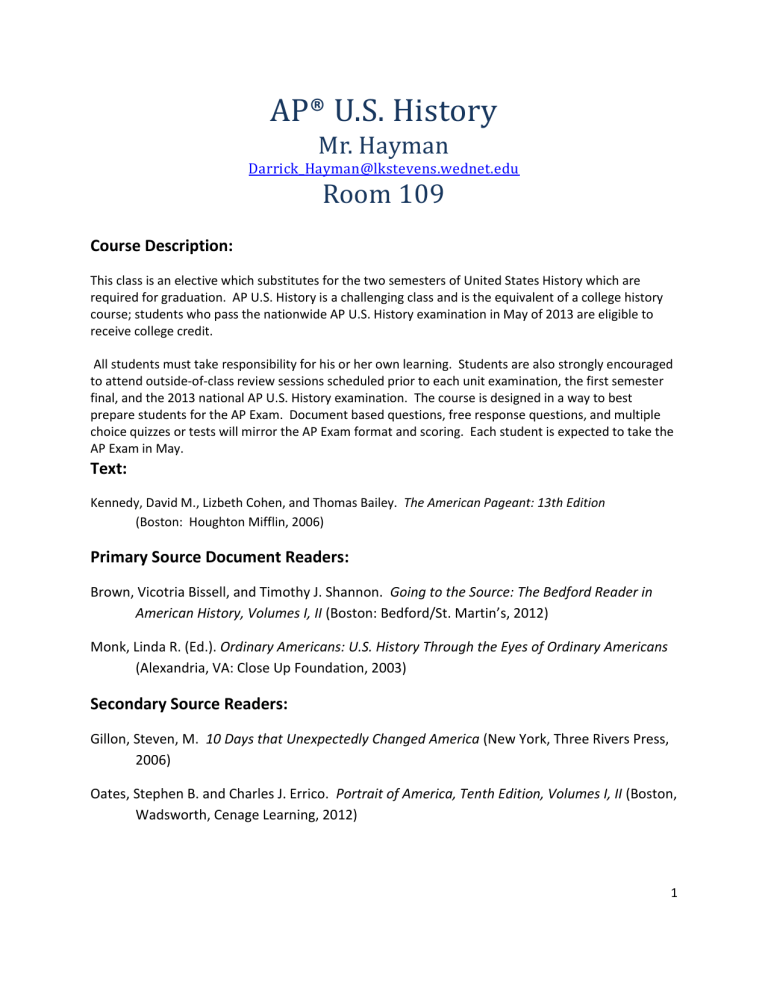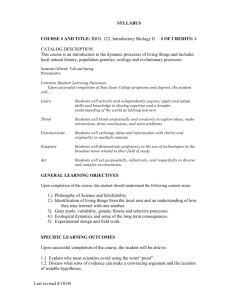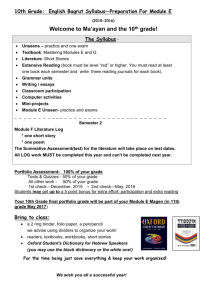AP® U

AP ® U.S. History
Mr. Hayman
Darrick_Hayman@lkstevens.wednet.edu
Room 109
Course Description:
This class is an elective which substitutes for the two semesters of United States History which are required for graduation. AP U.S. History is a challenging class and is the equivalent of a college history course; students who pass the nationwide AP U.S. History examination in May of 2013 are eligible to receive college credit.
All students must take responsibility for his or her own learning. Students are also strongly encouraged to attend outside-of-class review sessions scheduled prior to each unit examination, the first semester final, and the 2013 national AP U.S. History examination. The course is designed in a way to best prepare students for the AP Exam. Document based questions, free response questions, and multiple choice quizzes or tests will mirror the AP Exam format and scoring. Each student is expected to take the
AP Exam in May.
Text:
Kennedy, David M., Lizbeth Cohen, and Thomas Bailey. The American Pageant: 13th Edition
(Boston: Houghton Mifflin, 2006)
Primary Source Document Readers:
Brown, Vicotria Bissell, and Timothy J. Shannon. Going to the Source: The Bedford Reader in
American History, Volumes I, II (Boston: Bedford/St. Martin’s, 2012)
Monk, Linda R. (Ed.). Ordinary Americans: U.S. History Through the Eyes of Ordinary Americans
(Alexandria, VA: Close Up Foundation, 2003)
Secondary Source Readers:
Gillon, Steven, M. 10 Days that Unexpectedly Changed America (New York, Three Rivers Press,
2006)
Oates, Stephen B. and Charles J. Errico. Portrait of America, Tenth Edition, Volumes I, II (Boston,
Wadsworth, Cenage Learning, 2012)
1
Supplementary Text:
Newman, John L. and John M. Schmalbach, United States History: Preparing for the Advanced
Placement Examination, 2010 Edition (New York: Amsco School Publications, 2010)
All students will be required to purchase the above supplementary text at the beginning of the school year to supplement their textbook. It is also recommended that students purchase a quality AP US
History Exam review book (Kaplan, REA Fast Track to a Five, or AP Achiever) for use in April and early
May.
Course Objectives:
Students will:
Demonstrate a mastery of a broad body of historical knowledge
Use historical evidence to defend and support basic arguments and positions
Differentiate between various schools of historical thought and interpretation
Interpret and draw conclusions from various pieces of historical data including original documents, cartoons, graphs, maps, etc.
Demonstrate an effective use of analytical skills of evaluation, cause and effect relationships, and compare and contrast
Work effectively in groups to produce products, make presentations, and solve problems
Prepare for and receive a score of 3 or higher on the AP US History Exam
Students will be required to write often. Essay prompts may be previously asked AP US History essay questions or students may be asked to support an opinion based on class discussions, themes, or readings. Essays throughout the course will be based on document based questions or standard free response questions. Essays will be graded on the typical 9 point AP US History rubric using the following scale: 9=100, 9=95, 7=90, 6=85, 4=75, 3=70, 2=60, 1=30, 0=0. All essays will be in class timed writes.
Course Themes:
These themes are woven throughout the course and will serve as the basis for class discussions and will influence all tests and essays.
American Diversity
Development of a unique American identity
Evolution of American culture
Demographic change over the course of American history
Economic trends and transformations
Environmental issues
Development of political institutions and the components of citizenship
Social reform movements
The role of religion in the making of the United States and its impact in a multicultural society
History of slavery and its legacies in this hemisphere
War and diplomacy
Place of the United States in an increasingly global arena
2
The A.P. U.S. History Exam
The A.P. U.S. History exam, administered Wednesday May 15, 2013, is 3 hours and 5 minutes long. Half of the exam is a 55 minute, 80 question multiple choice section. 20% of the multiple choice questions cover American history through 1789, 45% of the multiple choice questions cover the years 1790-1914, and the remaining 35% of the multiple choice questions are taken from 1915 to the present. The other half of the exam is a 130 minute essay section. Students are required to answer three of the five essays.
The A.P. U.S. History exam is graded on a five point scale. Generally, most public universities award credit or placement to students who earn a 3 or higher while many private colleges require a score of 4 or higher. However, since each school is free to set its own policy, students need to check the specific policies of the institutions they are interested in attending.
All students enrolled in this class second semester are expected to take the A.P. U.S. History exam.
Each A.P. exam costs about $87. Any student who does not take the A.P. exam will be required to take a similar exam on the same day that will comprise 20% of that student’s second semester grade. Even so,
AP exam scores will not be linked to semester grades. In other words, no grade changes will be made on the basis of a student’s performance on the AP US History exam.
Grading
:
Your grade will be based upon performance in the following categories
Unit Exams: 30%
Timed Writes 20%
Chapter Homework 20%
Major Projects 10%
Other Assignments 10%
Midterm (or Final project): 10%
Grading scale:
100 - 90 = A
89-80 = B
79-70
69-60
=
=
C
D
Below 50 = F
3
Getting Help:
If you are having difficulty wrapping your mind around a concept or a discussion item in class please let me know. I am available before and after school. Email is a great way for me to help you as well! If you don’t ask questions, I assume that you are following along with me. As the AP exam approaches, we will have several review sessions after school. Saturday review sessions may also be a possibility as the need arises.
Plagiarism
The goal of putting effort into an assignment that you turn in for a grade is so that I, as a teacher, can assess how you well you are learning the material that I am teaching you. Copying material from a friend, the internet, or any other source and claiming it to be your own is dishonest and illegal.
Any student who turns in any assignment that has been copied or plagiarized from an outside source will receive a zero on the assignment. If you knowingly or willfully allow someone to copy your work, the same consequences will apply. If this trend continues the student will be referred to the administration.
If the incident occurs during first semester, you will not be allowed to enroll in this course for second semester. Incidents of plagiarism may restrict your enrollment in future AP courses.
Attendance
It is important that you be in class every day that we meet; it is exceedingly difficult for you to learn the subject matter if you are not in class. The LSHS attendance policy will be strictly adhered to.
If you are absent, please check my teacher page through the school website http://www.lkstevens.wednet.edu/page/2152 to get your makeup work.
Tardies
-1st Tardy----Free
-2nd – 6 th Tardy----30 minutes after school
-over six tardies will be referred to the office
4
AP U.S. History Syllabus Overview
The following summary is mean to highlight some of the key points from the syllabus about the course. Please read the entire syllabus for more details about AP U.S. History.
AP U.S. History is has hard or harder than a typical college survey political science class.
AP U.S. History students will read an entire college level textbook by mid-April.
Only students who are motivated, disciplined, and take initiative will do well.
Students will learn much more in an AP class than any regular class.
Students who take AP classes usually do much better in college
All students enrolled in 2 nd semester are expected to take the $87 AP Exam in May.
AP exam scores will not be factored into semester grades
Students will have to complete several large projects outside of class.
Any students caught cheating will face the consequences outlined in the syllabus.
I have read, understood, and will abide by all of the provisions of the entire AP US Government and Politics syllabus.
_____________________________________________________
(Print Student Name)
_____________________________________________________
(Student Signature)
I have read and reviewed this syllabus with my child and I am committed to help my child succeed in this course.
______________________________________________________
(Parent or Guardian Signature)
5




